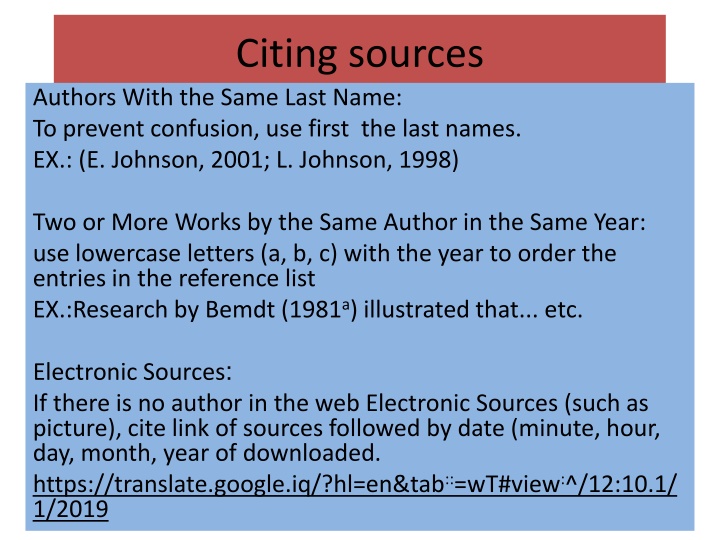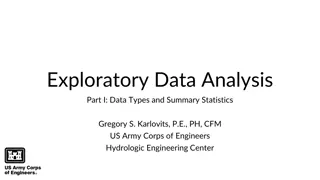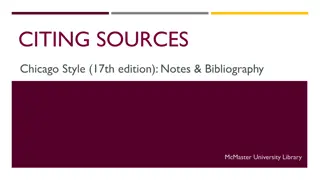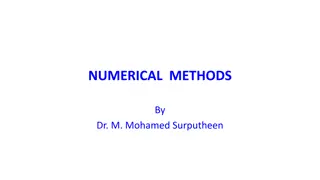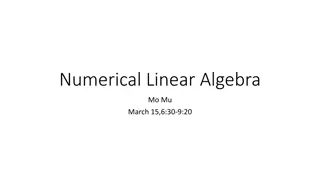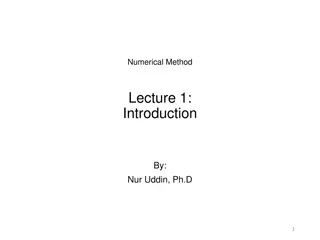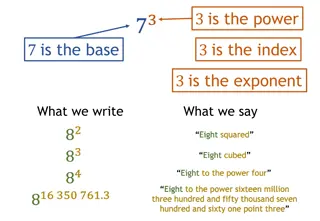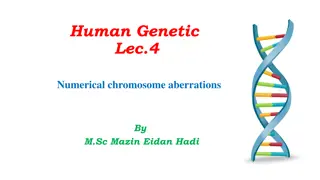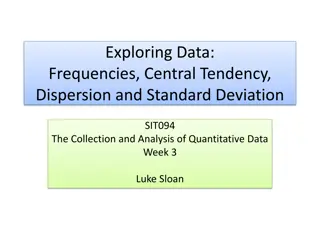Methods for Citing Sources & Numerical Systems
Explore guidelines for citing sources, handling authors with the same last names, and utilizing numerical systems like Vancouver style. Learn about formatting numbers and presenting data effectively in academic writing.
Download Presentation

Please find below an Image/Link to download the presentation.
The content on the website is provided AS IS for your information and personal use only. It may not be sold, licensed, or shared on other websites without obtaining consent from the author.If you encounter any issues during the download, it is possible that the publisher has removed the file from their server.
You are allowed to download the files provided on this website for personal or commercial use, subject to the condition that they are used lawfully. All files are the property of their respective owners.
The content on the website is provided AS IS for your information and personal use only. It may not be sold, licensed, or shared on other websites without obtaining consent from the author.
E N D
Presentation Transcript
Citing sources Authors With the Same Last Name: To prevent confusion, use first the last names. EX.: (E. Johnson, 2001; L. Johnson, 1998) Two or More Works by the Same Author in the Same Year: use lowercase letters (a, b, c) with the year to order the entries in the reference list EX.:Research by Bemdt (1981a) illustrated that... etc. : Electronic Sources If there is no author in the web Electronic Sources (such as picture), cite link of sources followed by date (minute, hour, day, month, year of downloaded. https://translate.google.iq/?hl=en&tab::=wT#view:^/12:10.1/ 1/2019
Vancouver style (numerical system) In this system numbered each source in the reference list and use the same number whenever you cite the source in the text . EX:microbiology is abranch of biology(1) EX: Daved(2) found that .. If you have more than two ref. to one text write them in serial numbers: EX:microbiology is abranch of biology(1-4) Or not as serial No. EX.: EX:microbiology is abranch of biology (1,3,7)
NUMBERS In beginning sentence avoid writing number that is not written out. EX.: ONE HUNDREDAND SEVENTEEN PROTESTS . EX.: Six hundred and thirty five nuggets were discovered . In dates ,fractions ,decimals and percentages use numbers EX.: 20 Percent (20%) ;1/2,Monday 20 April,1988
CHAPTER III Methodology of the Study Population, Sample Size, and Sampling Technique Description of Respondents Research instrument Data-Gathering Procedure Statistical Treatment of Data
CHAPTER IV Presentation ,Interpretation and Analysis of Data PRESENTATION OF DATA Present the findings of the study in the order of the specific problem as stated in the statement of the Problem. Present the data in these forms: Tabular Textual Graphical (optional)
CHAPTER IV INTERPRETATION OF DATA Establish interconnection between and among data Check for indicators whether hypothesis/es is/are supported or not by findings. Link the present findings with the previous literature. Use parallel observations with contemporary events to give credence presented in the introduction.
CHAPTER IV ANALYSIS OF DATA Data may be analyzed quantitatively or qualitatively depending on the level of measurement and the number of dimensions and variables of the study. Analyze in depth to give meaning to the data presented in the data presented in the table. Avoid table reading. State statistical descriptions in declarative sentences, e.g. in the studies involving:
CHAPTER V Conclusions and Recommendations CONCLUSIONS These are brief, generalized statements in answer to the general and each of the specific sub-problems. These contain generalized in relation to the population. These are general inferences applicable to a wider and similar population. Flexibility is considered in making of conclusions. It is not a must to state conclusions on a one-to-one correspondence with the problems and the findings as all variables can be subsume in one paragraph. Conclusions may be used as generalizations from a micro to a macrolevel or vice versa
CHAPTER V Conclusions and Recommendations RECOMMENDATIONS They should be based on the findings and conclusion of the study. Recommendations may be specific or general or both. They may include suggestions for further studies. They should be in non-technical language. They should be feasible, workable, flexible, doable, adaptable.
CHAPTER VI Bibliography Citing of sources used in the study
CHAPTER VI Bibliography Mitchell (2017) states Or (Mitchell, 2017).(one Author) Mitchell and Smith (2017) state Or (Mitchell & Smith, 2017). (Two Authors) Mitchell et al (2017) state Or (Mitchell et al, 2017).(Three or more Authors) Citing Authors With Multiple Works From One Year: (Mitchell, 2017a) Or (Mitchell, 2017b). Citing Multiple Works in One Parentheses: If these works are by the same author, the surname is stated once followed by the dates in order chronologically. Mitchell (2007, 2013, 2017) Or (Mitchell, 2007, 2013, 2017) If these works are by multiple authors then the references are ordered alphabetically by the first author separated by a semicolon as follows: (Mitchell & Smith 2017; Thomson, Coyne, & Davis, 2015).
Book referencing Jones, A.F & Wang, L. (2011). Spectacular creatures: The Amazon rainforest (2nd ed.). San Jose, Costa Rica: My Publisher Cite a Chapter in an Edited Book
Book referencing Troy, B.N. (2015). APA citation rules. In S.T, Williams (Ed.). A guide to citation rules (2nd ed., pp. 50-95). New York, NY: Publishers. Cite an E-Book The basic structure is as follows: Author surname, initial(s) (Ed(s).*). (Year). Title (ed.*). Retrieved from URL *optional. EX.: Mitchell, J.A., Thomson, M., & Coyne, R.P. (2017). A guide to citation. Retrieved from https://www.mendeley.com/reference- management/reference-manager
Book referencing Cite an E-Book Chapter Last name of the chapter author, initial(s). (Year). Chapter title. In editor initial(s), surname (Ed.). Title (ed., pp.chapter page range). Retrieved from URL Troy, B.N. (2015). APA citation rules. In S.T, Williams (Ed.). A guide to citation rules (2nd ed., pp. 50-95). Retrieved from https://www.mendeley.com/reference management/reference-manager
Cite a Journal Article in Print or Online Journal Article Examples: Mitchell, J.A. (2017). Citation: Why is it so important. Mendeley Journal, 67(2), 81-95. Mitchell, J.A. (2017). Citation: Why is it so important. Mendeley Journal, 67(2), 81-95. Retrieved from https://www.mendeley.com/reference-management/reference- manager.
